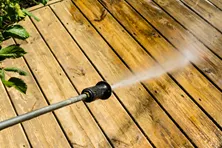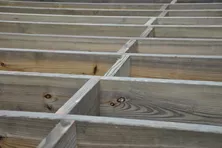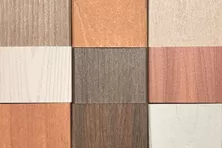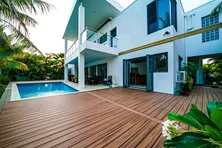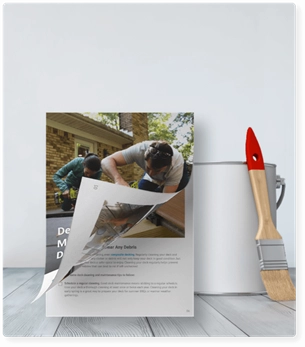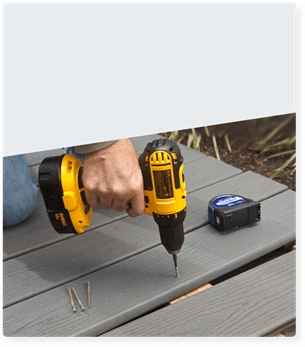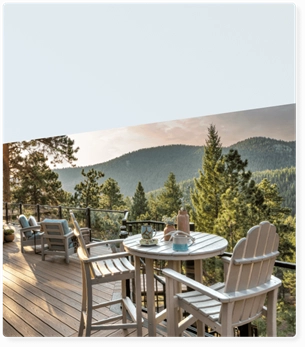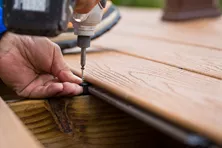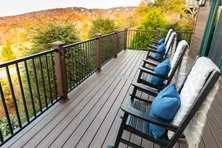How to Clean a Composite or Wood Deck
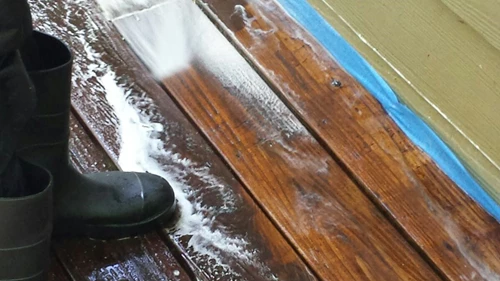
Designing and building a deck suited to your wants and needs can be fun and exciting. But when it comes to care and maintenance, it’s important to know what you’re getting yourself into beforehand. Examine the pros and cons of composite or wood decking -- specifically when it comes to how to clean your decking. And in addition to routine cleaning, you should also be aware of other maintenance work you may need to do from time to time on your deck.
For natural wood lovers, properly cleaning a wood deck requires annual care. You can buy deck cleaning solution at your local hardware store or make your own homemade concoctions from various household products that are effective in fighting mildew, algae, oil and debris.
In addition to cleaning, you’ll also need to routinely stain or seal your natural deck to keep it looking fresh and protect it from the harsh effects of elemental damage -- mainly heat and moisture. In some cases, your natural wood deck may also splinter, requiring sanding or replacing loose boards from time to time.
Composite decks on the other hand, offer a lower level of all-around maintenance – they won’t splinter and you don’t need to worry about periodic staining, painting or sealing projects.
Let’s learn more about tackling cleaning and keeping your deck in great shape!
Deck Cleaning Solutions & Materials Needed
Washing your deck consists of scrubbing it with a deck cleaning solution and a stiff bristle brush. You will need a bucket, cleaner, garden hose with a water nozzle or power washer, and a brush with an extension pole – unless you want to be scrubbing on your hands and knees.
Additionally, there are a number of safe, homemade cleaning solutions you can use on your deck, regardless of whether you have a natural wood or composite deck. These ingredients can be purchased from your local hardware or general store.
Depending on which homemade recipe you follow and whether you’ve got a natural or composite deck, various proportions and combinations of the following items can help you keep your deck in top condition. They include:
- Warm water can be used on its own to wash a wood or composite deck.
- Liquid dish soap (ammonia-free) is safe for use on cleaning your deck when mixed with a little warm water. Simply mix 1 gallon of water, 2 tablespoons of ammonia-free dish soap (such as Murphy’s), 1 pint of rubbing alcohol, and 1 quart of oxygen bleach. Be very careful and only use ammonia free dish soap. Otherwise, if ammonia is mixed with bleach, it can create toxic fumes. Once you’ve blended your mixture, swab it on your deck and rinse it clean with water.
- Oxygen bleach or powdered oxygen laundry cleaner is safe for use on wood decks and useful in removing mold or spores. When cleaning your deck, make sure you only use oxygen bleach and not chlorine bleach, which can compromise the structural integrity of your wood deck.
- Vinegar - Safe for both composite and wood decking, mix a half-cup of white vinegar or apple cider vinegar to ¼ a cup of baking soda with 1 gallon of water.
How to Clean a Wood Deck
Natural wood decks have the potential to look great if they’re well-maintained. But the amount of summer wear and tear from cookouts and backyard fun combined with the harsh winter cold and frost can really do a number on a real wood deck over time, unless you stay on top of cleaning and caring for it.
Check out the steps below for how to properly clean wood decking:
- Step 1: Pre-rinse your deck
First, spritz the deck with water to soften the dried cellulose fibers. This 'pre-rinse' will also allow for the cleaning solution to be more easily dispersed throughout the deck. - Step 2: Mix your chosen solution
Mix your cleaning solution in a 5-gallon bucket with water following the instructions on the container. - Step 3: Scrub with the grain
Next you can begin to scrub the deck with the grain using your stiff bristle brush to remove dirt, mildew, mold, stains etc.
TIP: If the deck surface is large, mix and divide multiple batches of cleaning solution. The concentration of the cleaning solution should remain consistent throughout the project. - Step 4: Rinse thoroughly
You can then use your garden hose or a pressure washer to rinse the surface of the deck. Try to time your deck cleaning project for nice weather. It is best if you can allow your deck to dry for 24-48 hours before staining and sealing.
How to Clean a Composite Deck
Regular maintenance keeps your composite deck looking its best and helps extend its lifespan. Unlike natural wood, composite decking requires a gentler approach to prevent damage. Avoid using harsh chemicals, as they can damage the surface. Instead, follow these steps to keep your deck looking its best.
- Step 1: Remove Debris
Sweep leaves, dirt, and dust off the deck regularly. Clear out gaps between boards to prevent mold and mildew buildup. - Step 2: Rinse the Surface
Spray the deck with a garden hose or a low-pressure power washer (maximum 3100 psi) to wash away loose dirt and grime. - Step 3: Scrub with a Mild Cleaner
Apply a mixture of warm water and mild soap or a composite deck cleaner. Use a soft-bristle brush or sponge to scrub soiled areas, loosening dirt and stains without damaging the surface. - Step 4: Rinse Thoroughly
Wash away all soap and cleaner with a garden hose. Ensure no residue is left behind, as it can create a dull film on the surface.
Removing mold from your composite decking
For mold removal, try cleaning composite decking with vinegar.
- Step 1: Pre-rinse
Use your hose or power wash to remove as much of the surface mold as possible. - Step 2: Mix your vinegar solution
Next, mix two parts vinegar and one part water into a bucket. Pour the solution directly on the mold. - Step 3: Sprinkle baking soda
After the solution is poured, sprinkle some baking soda on the area well. Let the compound sit and soak for 20 minutes and then scrub the area with your gentle bristle brush to remove any leftover mold and mildew. - Step 4: Rinse thoroughly
Finally, thoroughly wash the area clean to avoid leaving a layer of film.
And that’s it! With just a little soapy water, some gentle pressure, and the cleaning tips for composite decking or wood decking above, you can keep your deck clean and in peak condition. That’s what we call maximum outdoor living with minimal maintenance!
How to Pressure Wash a Deck
Pressure washing your deck is the best way to keep your investment looking like new. Learn how to properly clean your wood deck with these tips from Decks.com.
Deck Maintenance Checklist
Wondering how to best care for your deck? Download our comprehensive deck maintenance checklist to ensure your deck is safe and lasts for years at Decks.com.
How to Avoid, Prevent & Repair Deck Joist Rot
Rotted deck joists can cause homeowners headaches. Learn more about how to avoid, prevent and repair deck joist rot at Decks.com.
Capped Composite Decking
What is capped composite decking? It's a great option if you like the look of wood but not the maintenance. Learn about capped composite at Decks.com.
Pool Decking Options
When choosing a pool deck material, you should consider slip-resistance, heat absorption and more. Find the best material for your pool deck with Decks.com.
More Helpful Resources
Explore Articles by Topic

Footings
Information related to installing frost footings for decks

Framing
Learn structural framing methods

Decking
Learn about wood and composite decking materials

Stairs
An in-depth look at the complex issue of how to build stairs

Railings
How to install guardrails and handrails to meet IRC code

Features
An overview on water drainage, benches, planters and lights

Design
The basics of deck design

Planning
Learn about permits and working with contractors

Porches & Patios
Build a covered deck to enjoy all seasons

Ledger
Proper attachment techniques

Care
Maintain your deck to maintain your investment

Materials
An overview on water drainage, benches, planters and lights
How to Remove Scuffs and Scratches from Composite Decking
Removing scuffs and scratches can help make your composite deck look like new. Learn how to fix and prevent your composite deck from future scratches.
How to Replace Deck Boards & Repair Your Deck
Deck boards can split, rot or come loose over time, but it’s easy to remove and replace deck boards without rebuilding the whole deck. Learn how from the experts at Deck.com.
Deck Maintenance Checklist
Wondering how to best care for your deck? Download our comprehensive deck maintenance checklist to ensure your deck is safe and lasts for years at Decks.com.
Is Trex Decking Worth the Investment? Expert Insights and Reviews
Discover why Trex decking is worth the investment. Learn about its durability, low maintenance, eco-friendliness, and the long-term value it adds to your home.
Best Composite Decking Materials & Options
Low maintenance composite decking materials are a great option when thinking long-term. Discover the best composite decking material options for your home.
Deck Screws vs Wood Screws
Your guide to understanding the differences between wood deck screws and composite deck screws.
Explore Articles by Topic

Footings
Information related to installing frost footings for decks

Framing
Learn structural framing methods

Decking
Learn about wood and composite decking materials

Stairs
An in-depth look at the complex issue of how to build stairs

Railings
How to install guardrails and handrails to meet IRC code

Features
An overview on water drainage, benches, planters and lights

Design
The basics of deck design

Planning
Learn about permits and working with contractors

Porches & Patios
Build a covered deck to enjoy all seasons

Ledger
Proper attachment techniques

Care
Maintain your deck to maintain your investment

Materials
An overview on water drainage, benches, planters and lights




